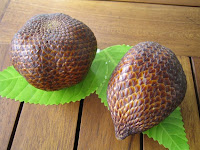THE MONKEY HAND TREE, CHIRANTHODENDRON PENTADACTYLON
The Monkey Hand Tree is also called the Mexican Hand Tree and Devil’s Hand Tree, because the five stamens of the flower protrude from the petals, which form a cup shape, or a cuff shape, and look like a hand with five fingers. Its botanical name Chiranthodendron means “hand flower tree” in Greek and pentadactylon, also Greek, means five-fingered. Its botanical synonym is Cheirostemon platnoides.
It has an interesting history as it was believed by the Mexican Aztecs that the single tree growing in the Toluca Valley was the only one, and that this unique tree had been a present from the gods. To prevent it reproducing they would pick every flower from the tree, and these would have been dried for use by the shamans, and for medicine. It was highly revered as a spiritual and medicinal tree. It was not found by “outsiders” until the 18th century, and in the 19th a forest of such trees was discovered along the Mexico-Guatemala border. It is now known that these trees grow in mixed oak and pine forests.
 Despite the fact that the Indians picked all the blossoms from the tree, some were cultivated in gardens, and some given as regal gifts. This tree is the only one in the Chiroanthodendron genus, although it is closely related to Fremontodendron, a hybrid with yellow flowers with a smaller claw. It is a member of the Sterculiaceae family (cacao family) of plants.
Despite the fact that the Indians picked all the blossoms from the tree, some were cultivated in gardens, and some given as regal gifts. This tree is the only one in the Chiroanthodendron genus, although it is closely related to Fremontodendron, a hybrid with yellow flowers with a smaller claw. It is a member of the Sterculiaceae family (cacao family) of plants. The Mexican Hand Tree was documented botanically by José Dionisia Larreátegui in his “Description Botanique du Chiroanthodendron” published in 1805 in French and Spanish. In Spanish the tree is called árbol de las manitas, or tree of the little hands. It was first seen by Professor Cervantes in 1795 and it was he who first described it to fellow botanists, and a student of his who found the forest of Monkey Hand Trees on the Mexican –Guatemalan border in 1801.
 The natives used this tree to sure a variety of ailments, including epilepsy, for eye problems, and as a cardiac tonic. The flowers are said to cure heart disease and are sold in Mexican markets and some in south west USA. The Aztecs usually used the flowers for medicines, and these bloom from late spring to early summer. They used the bark and leaves for swelling and pain in the genitals, and believed the tree and its parts were beneficial not only to the heart but also to the nervous system.
The natives used this tree to sure a variety of ailments, including epilepsy, for eye problems, and as a cardiac tonic. The flowers are said to cure heart disease and are sold in Mexican markets and some in south west USA. The Aztecs usually used the flowers for medicines, and these bloom from late spring to early summer. They used the bark and leaves for swelling and pain in the genitals, and believed the tree and its parts were beneficial not only to the heart but also to the nervous system. The parts of the tree were believed to have sedative, analgesic and anti-inflammatory properties. Modern medical research has shown that the use of this tree in gastrointestinal disorders is sound as the flavonoid epicatechin found in it is most effective against such amoebae that cause dysentery and diarrhoea. The catechin and isoquercetin it contains are also effective for the same problems, but to a lesser degree. Victor R Preedy in “Botanical medicine in clinical procedures” states that the Monkey Hand Tree is the “most effective herb against amoebic infections” that he tested.
 These trees can grow to heights of 40 feet and are quite fast-growing, with large leaves which are covered with brown wooly hairs on their undersides. When the flowers die back they are followed by woody pods containing several seeds, and these pods can stay on the trees for several months. Like the Cannonball tree and the citron fruit, this tree is something of a curiosity.
These trees can grow to heights of 40 feet and are quite fast-growing, with large leaves which are covered with brown wooly hairs on their undersides. When the flowers die back they are followed by woody pods containing several seeds, and these pods can stay on the trees for several months. Like the Cannonball tree and the citron fruit, this tree is something of a curiosity.















































